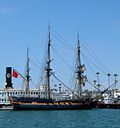 | |
| Established | 1948 |
|---|---|
| Location | San Diego, California, United States |
| Coordinates | 32°43′14″N117°10′24″W / 32.720639°N 117.173417°W |
| Type | Maritime museum |
| Key holdings | Star of India Berkeley Californian Medea |
| Visitors | 220,000 [1] |
| President | DR. Christina Brophy |
| Public transit access | County Center/Little Italy |
| Nearest car park | Street |
| Website | www |
The Maritime Museum of San Diego is a maritime museum in San Diego, California. Established in 1948, it preserves one of the largest collections of historic sea vessels in the United States. Located on San Diego Bay, the centerpiece of the museum's collection is Star of India , an 1863 iron barque. The museum maintains the MacMullen Library and Research Archives aboard the 1898 ferryboat Berkeley . It publishes the quarterly peer-reviewed journal Mains'l Haul: A Journal of Pacific Maritime History.






